

- Homebrew run macvim mac os x#
- Homebrew run macvim install#
- Homebrew run macvim update#
- Homebrew run macvim archive#
Use fakeclip pseudo clipboard register for non-GUI version of Vim on Cygwin and Mac OS X Vnoremap y ::let \| execute "normal! vgvy" \| let res=system("pbcopy", \| let the trick is to use "vgvy" to grab the selection into default register and feed into pbcopy. Update: There is a potential fix for the non-whole line case (I use the keystroke leader + y instead of F2 for mapping): Later I will try to figure out a workaround. I'm working with the non-GUI version on Mac OS X. If you in visual mode however, it will grab all the selected text.Ĭomment: the nmap commands work perfectly, but unfortunately the vmap-copy doesn't (it grabs the whole line instead of the selected text). If you are in normal mode, it will just grab the line your working on. The nopaste setting makes sure that auto-indent doesn't go crazy when you try to paste something in. pastes, but I have it configured so it works very well in insert mode and in normal mode.My maps just add onto what these guys have worked on. Pressing copies the current line to the clipboard, pressing pastes the current content from the clipboard. I use 4,8w !pbcopy which prevents the deletion of lines within the window-file where I run the command. I failed to mention that I compile Vim with '-without-x -disable-gui' therefore I don't have access to the unnamed registers. I find that the + register works for transferring back and forth to the OS X clipboard.
Homebrew run macvim install#
You can use homebrew to install the latest vim and your clipboard should work in the terminal. Operations such as yy, D, and P work with the system clipboard. :r !pbpaste "Paste clipboard content to current lineįor MacVim and Windows Gvim, I have the following in my ~/.vimrc: :!echo "%:p" | pbcopy "Copy current filename to clipboard

Homebrew run macvim update#
You may need to use `brew install vim` to update to Vim 7.4 instead of the default 7.3. Just repeat open -e ~/.You can also use pbcopy/pbpaste command to achieve the same thing.

Note that vim-latex requires you to set some settings in your. That's how pathogen works for virtually all plugins. If you want to open ~/.vim/bundle in Finder, just type open ~/.vim/bundleĪnd you will get a nice file manager to help you. Now, I'll simply get the whole vim-latex-1.8.23-20130116.788-git2ef9956 directory and move/copy it inside ~/.vim/bundle. That's it.įor example, I got this file, vim-latex-1.8. Now, if you want to deploy any Vim plugin, just extract it and put the extracted directory under ~/.vim/bundle. Note: The only required line for pathogen to work is the first one, the other two are just some goodies I recommend. Type this command: open -e ~/.vimrcĪnd add the following lines, preferably in the beginning: execute pathogen#infect() This command will download pathogen.vim from Tim's repository and deploy it inside the autoload directory. Now, let's type this command: curl -LSso ~/.vim/autoload/pathogen.vim vim directory, if it doesn't exist), autoload and bundle inside. This will create two directories (and even the parent. The solution relies on Tim Pope's awesome pathogen plugin, which manage our runtimepath very easily.įirst of all, open your terminal and type the following: mkdir -p ~/.vim/autoload ~/.vim/bundle I don't use it, but I can provide a very clean way of deploying plugins for Vim. If you use Homebrew, there's already a formula for MacVim available, so you can run brew install macvim
Homebrew run macvim archive#
Getting the correct MacVim version for your operating system in the project website, unzip the archive file and drag MacVim.app to your Applications folder. For Macs, we have MacVim, and AFAIK two options are available:

Usually, the installation is very straightforward for every operating system. I suppose you already have Vim installed in your operating system.


 0 kommentar(er)
0 kommentar(er)
